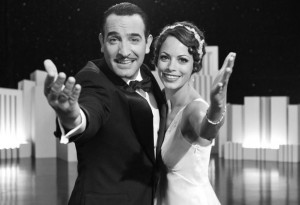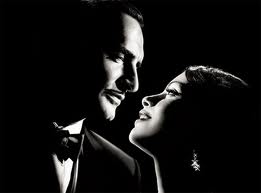
![]()
“The Artist” achieves the remarkable. It is a story relayed in a format as old as cinema itself: The silent film. Yet “The Artist” is a revelation, full of life and as refreshing as any movie you will see this year.
It is 1927 and the beginning of the end for George Valentin (Jean Dujardin), a superstar of the silver screen grinning his way through life in Hollywoodland. Valentin is the perfect silent film actor and can convey a thousand words with the movement of a hand and the arch of his brow. But this skill becomes obsolete with the birth of the “talkies” and instantly Valentin is relic, a dinosaur no longer needed or wanted.
At the same time we see the rise of the fresh, new ingénue aptly named Peppy Miller (Berenice Bejo). She embraces the new technology and becomes a celebrated talent nearly overnight. A new sort of talent that can dance and sing! Meanwhile Valentin plunges deep in depression and loses everything: his wife, his home and, most importantly, his pride. He is a true artist but his craft is no longer appreciated or wanted.
“The Artist” is the perfect companion piece to Martin Scorsese’s recent “Hugo” as both films gracefully takes us back to the beginnings of cinema. Both films center on a great talents who become antiques as the world changes around them. Both are also a pair of the best movies of this year and will no doubt go to blows for the Best Picture honor.

Dujardin and Bejo are perfect as silent film stars. Dujardin seems cut from the same cloth as the swashbuckling heroes of the twenties and has the most winning smile that makes you instantly become a fan. Bejo, with her long limbs and gorgeous eyes, is a revelation. Both of these actors are lucky that a silent film has been made to showcase their unique talents.
Writer and director Michel Hazanavicius (who is, coincidentally, married to Bejo) has created a legitimate silent film that does not make fun of the art form but embraces it. This isn’t Mel Brooks’ “The Silent Movie”. There is no cynicism on display, just a love for the lost technique. Hazanavicius’ mastery of pantomime and title cards to tell a story is remarkable. Combined with the brilliant and well suited score by Ludovic Bource, “The Artist” is a legitimate treasure that could pass as authentic next to any of the classics from the silent era.

Something special happens to the mind as you watch a silent film. We are asked for fill in the blanks, to analyze more than we are used to doing. In fact big, dumb summer movies are more often asking you to not think at all. A silent film demands more interaction, more focus. A stronger relationship between the story and the viewer can be developed because of this. As a result, “The Artist” feels like a dream you have lived through as opposed to something lifeless you merely watched.


